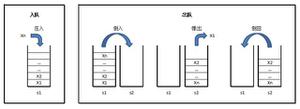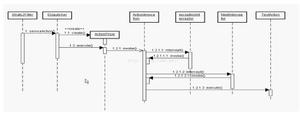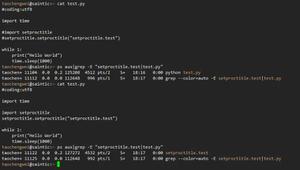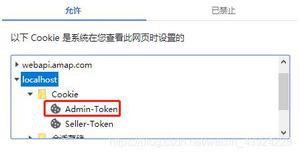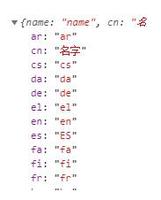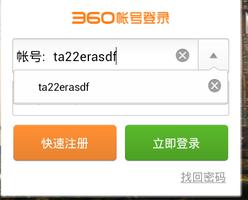struts2与cookie 实现自动登录和验证码验证实现代码
主要介绍struts2与cookie结合实现自动登录
struts2与cookie结合时要注意采用.action 动作的方式实现cookie的读取
struts2的jar包
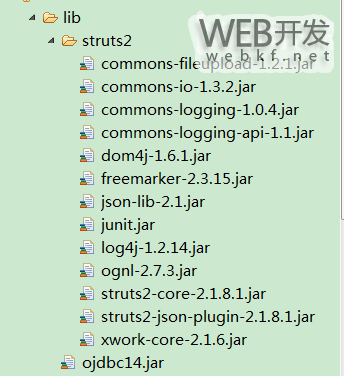
链接数据库文件 db.properties
dbDriver = oracle.jdbc.driver.OracleDriver
url = jdbc:oracle:thin:@localhost:1521:orcl
userName=test
password=password
dao层类代码,通过登录名获取用户信息
package com.struts.dao.impl;
import java.sql.Connection;
import java.sql.PreparedStatement;
import java.sql.ResultSet;
import java.sql.SQLException;
import com.struts.dao.UserDao;
import com.struts.proj.User;
import com.struts.util.BeanConnection;
public class UserDaoImpl implements UserDao {
private BeanConnection dbconn = new BeanConnection();
public User login(String loginname) {
Connection conn = dbconn.getConnection();
ResultSet rs = null ;
String selsql = "select * from t_scoa_sys_user where f_loginname='"+loginname+"'";
//System.out.println(selsql);
PreparedStatement pstmt = null;
User user = null;
try {
pstmt = conn.prepareStatement(selsql);
//pstmt.setString(3, loginname);
rs = pstmt.executeQuery();
while(rs.next()){
user = new User();
user.setId(rs.getLong(1));
user.setF_username(rs.getString(2));
user.setF_loginname(rs.getString(3));
user.setF_sex(rs.getString(4));
user.setF_state(rs.getString(5));
user.setF_email(rs.getString(6));
user.setF_mobilephone(rs.getString(7));
user.setF_secretaryid(rs.getLong(8));
user.setF_password(rs.getString(9));
user.setF_order(rs.getLong(10));
user.setF_note(rs.getString(11));
user.setF_infomodifytemplateid(rs.getLong(12));
}
} catch (SQLException e) {
e.printStackTrace();
}
return user;
}
public void save(User user) {
}
public static void main(String[] args) {
UserDaoImpl daoimpl = new UserDaoImpl();
daoimpl.login("admin");
}
}
工具类 CookieUtils类
package com.struts.util;
import javax.servlet.http.Cookie;
import javax.servlet.http.HttpServletRequest;
import javax.servlet.http.HttpSession;
import org.apache.commons.lang.xwork.StringUtils;
import org.apache.struts2.ServletActionContext;
import com.struts.action.LoginAction;
import com.struts.proj.User;
import com.struts.service.UserService;
import com.struts.service.impl.UserServiceImpl;
public class CookieUtils {
public static final String USER_COOKIE = "user.cookie";
// 增加cookie
public Cookie addCookie(User user) {
Cookie cookie = new Cookie(USER_COOKIE, user.getF_loginname() + ","
+ DESEDE.decryptIt(user.getF_password()));
cookie.setMaxAge(60 * 60 * 24 * 365);
return cookie;
}
// 得到cookie
public boolean getCookie(HttpServletRequest request, UserService userService) {
request = ServletActionContext.getRequest();
Cookie[] cookies = request.getCookies();
userService = new UserServiceImpl();
if (cookies != null) {
for (Cookie cookie : cookies) {
if (CookieUtils.USER_COOKIE.equals(cookie.getName())) {
String value = cookie.getValue();
// 判断字符是否为空
if (StringUtils.isNotBlank(value)) {
String[] spilt = value.split(",");
String loginname = spilt[0];
String password = spilt[1];
User user = userService.login(loginname, password);
if (user != null) {
HttpSession session = request.getSession();
session
.setAttribute(LoginAction.USER_SESSION,
user);// 添加用户到session中
return true;
}
}
}
}
}
return false;
}
// 删除cookie
public Cookie delCookie(HttpServletRequest request) {
request = ServletActionContext.getRequest();
Cookie[] cookies = request.getCookies();
if (cookies != null) {
for (Cookie cookie : cookies) {
if (USER_COOKIE.equals(cookie.getName())) {
cookie.setValue("");
cookie.setMaxAge(0);
return cookie;
}
}
}
return null;
}
}
service层代码,验证用户名和密码是否正确,密码我本地用了加密算法,需要解密,友友们可以去掉
package com.struts.service.impl;
import com.struts.dao.UserDao;
import com.struts.dao.impl.UserDaoImpl;
import com.struts.proj.User;
import com.struts.service.UserService;
import com.struts.util.DESEDE;
public class UserServiceImpl implements UserService {
UserDao userDao = new UserDaoImpl();
public User login(String loginname, String password) {
User user = userDao.login(loginname);
if (user == null) {
System.out.println("用户名不存在,请检查后重新登录!");
}
if (!DESEDE.decryptIt(user.getF_password()).equals(password)) {
System.out.println("密码错误");
}
return user;
}
public static void main(String[] args) {
UserServiceImpl useimp = new UserServiceImpl();
System.out.println(useimp.login("admin", "1234"));
}
}
struts2的配置文件struts.xml,loginAction和ValidateCodeAction验证码的验证
<?xml version="1.0" encoding="UTF-8" ?>
<!DOCTYPE struts PUBLIC
"-//Apache Software Foundation//DTD Struts Configuration 2.1//EN"
"http://struts.apache.org/dtds/struts-2.1.dtd">
<struts>
<constant name="struts.i18n.reload" value="true" />
<constant name="struts.devMode" value="true" />
<package name="loginResult" extends="struts-default" namespace="/">
<action name="loginAction" class="com.struts.action.LoginAction">
<result name="success" type="redirect">/success.jsp</result>
<result name="error">/error.jsp</result>
<result name="login" type="redirect">/login.jsp</result>
</action>
<!-- 验证码 -->
<action name="validate" class="com.struts.action.ValidateCodeAction">
<param name="width">60</param>
<param name="height">20</param>
<param name="fontSize">18</param>
<param name="codeLength">4</param>
<result type="stream">
<param name="contentType">image/jpeg</param>
<param name="inputName">inputStream</param>
</result>
</action>
</package>
</struts>
action文件类 LoginAction
package com.struts.action;
import java.util.Map;
import javax.servlet.http.Cookie;
import javax.servlet.http.HttpServletRequest;
import javax.servlet.http.HttpServletResponse;
import javax.servlet.http.HttpSession;
import org.apache.struts2.ServletActionContext;
import com.opensymphony.xwork2.ActionContext;
import com.opensymphony.xwork2.ActionSupport;
import com.struts.proj.User;
import com.struts.service.UserService;
import com.struts.service.impl.UserServiceImpl;
import com.struts.util.CookieUtils;
import com.struts.util.DESEDE;
public class LoginAction extends ActionSupport {
private static final long serialVersionUID = 6650955874307814247L;
private String f_loginname;
private String f_password;
private HttpServletResponse response;
private HttpServletRequest request;
private Map<String, Object> session;
private CookieUtils cookieUtils = new CookieUtils();
private boolean userCookie;
private String validateCode;
public static final String USER_SESSION = "user.session";
UserService userService = new UserServiceImpl();
public String autoLogin() throws Exception {
request = ServletActionContext.getRequest();
if (cookieUtils.getCookie(request, userService)) {
return "success";
} else
return "login";
}
@Override
public String execute() throws Exception {
HttpSession session = ServletActionContext.getRequest().getSession();
try {
String code = (String) session.getAttribute("validateCode");
if (validateCode == null || !validateCode.equals(code)) {
System.out.println("验证码输入有误,请正确输入");
return "error";
}
if (f_loginname != null && !"".equals(f_loginname)
&& !"".equals(f_password) && f_password != null) {
User user = userService.login(f_loginname, f_password);
// 判断是否要添加到cookie中
String psswd = DESEDE.decryptIt(user.getF_password());
if (user != null && psswd.equals(f_password)) {
if (userCookie) {
Cookie cookie = cookieUtils.addCookie(user);
ActionContext.getContext().get("response");
ServletActionContext.getResponse().addCookie(cookie);
}
session.setAttribute(USER_SESSION, user);
return "success";
}
}
} catch (Exception e) {
e.printStackTrace();
}
return "login";
}
// 用户退出
public String logout() {
request = ServletActionContext.getRequest();
response = ServletActionContext.getResponse();
HttpSession session = ServletActionContext.getRequest().getSession();
session = request.getSession(false);
if (session != null)
session.removeAttribute(USER_SESSION);
Cookie cookie = cookieUtils.delCookie(request);
if (cookie != null)
response.addCookie(cookie);
return "login";
}
public static void main(String[] args) {
LoginAction login = new LoginAction();
try {
login.execute();
} catch (Exception e) {
e.printStackTrace();
}
}
public Map<String, Object> getSession() {
return session;
}
public void setSession(Map<String, Object> session) {
this.session = session;
}
public HttpServletResponse getResponse() {
return response;
}
public void setResponse(HttpServletResponse response) {
this.response = response;
}
public HttpServletRequest getRequest() {
return request;
}
public void setRequest(HttpServletRequest request) {
this.request = request;
}
public boolean isUserCookie() {
return userCookie;
}
public void setUserCookie(boolean userCookie) {
this.userCookie = userCookie;
}
public String getF_loginname() {
return f_loginname;
}
public void setF_loginname(String fLoginname) {
f_loginname = fLoginname;
}
public String getF_password() {
return f_password;
}
public void setF_password(String fPassword) {
f_password = fPassword;
}
public String getValidateCode() {
return validateCode;
}
public void setValidateCode(String validateCode) {
this.validateCode = validateCode;
}
}
验证码 ValidataCodeAction ,网上很多验证码的例子,可以选择自己的方式来写验证码
package com.struts.action;
import java.awt.Color;
import java.awt.Font;
import java.awt.Graphics;
import java.awt.image.BufferedImage;
import java.io.ByteArrayInputStream;
import java.io.ByteArrayOutputStream;
import java.util.Random;
import javax.imageio.ImageIO;
import javax.imageio.stream.ImageOutputStream;
import com.opensymphony.xwork2.ActionContext;
import com.opensymphony.xwork2.ActionSupport;
public class ValidateCodeAction extends ActionSupport {
private static final long serialVersionUID = 1L;
private ByteArrayInputStream inputStream;
private int width;
private int height;
private int fontSize;
private int codeLength;
public ValidateCodeAction() {
}
public void setCodeLength(int codeLength) {
this.codeLength = codeLength;
}
public void setFontSize(int fontSize) {
this.fontSize = fontSize;
}
public void setHeight(int height) {
this.height = height;
}
public void setWidth(int width) {
this.width = width;
}
public ByteArrayInputStream getInputStream() {
return inputStream;
}
public void setInputStream(ByteArrayInputStream inputStream) {
this.inputStream = inputStream;
}
public String execute() throws Exception {
BufferedImage bimage = new BufferedImage(width, height, 1);
Graphics g = bimage.getGraphics();
Random random = new Random();
g.setColor(getRandomColor(random, 200, 255));
g.fillRect(0, 0, width, height);
g.setFont(new Font("Times New Roman", 0, fontSize));
g.setColor(getRandomColor(random, 160, 200));
for (int i = 0; i < 155; i++) {
int x = random.nextInt(width);
int y = random.nextInt(height);
int xl = random.nextInt(12);
int yl = random.nextInt(12);
g.drawLine(x, y, x + xl, y + yl);
}
StringBuffer str = new StringBuffer();
for (int i = 0; i < codeLength; i++) {
String randomStr = String.valueOf(random.nextInt(10));
str.append(randomStr);
g.setColor(new Color(20 + random.nextInt(110), 20 + random
.nextInt(110), 20 + random.nextInt(110)));
int x = (width / codeLength - 1) * i
+ random.nextInt(width / (codeLength * 2));
int y = random.nextInt(height - fontSize) + fontSize;
g.drawString(randomStr, x, y);
}
ActionContext.getContext().getSession().put("validateCode",
str.toString());
g.dispose();
ByteArrayOutputStream output = new ByteArrayOutputStream();
ImageOutputStream iout = ImageIO.createImageOutputStream(output);
ImageIO.write(bimage, "JPEG", iout);
iout.close();
output.close();
ByteArrayInputStream in = new ByteArrayInputStream(output.toByteArray());
setInputStream(in);
return "success";
}
private Color getRandomColor(Random random, int fc, int bc) {
if (fc > 255)
fc = 255;
if (bc > 255)
bc = 255;
int r = fc + random.nextInt(bc - fc);
int g = fc + random.nextInt(bc - fc);
int b = fc + random.nextInt(bc - fc);
return new Color(r, g, b);
}
}
登录成功页面success.jsp
<%@ page language="java" import="java.util.*" pageEncoding="UTF-8"%>
<%@page import="com.struts.util.CookieUtils"%>
<%@page import="org.apache.commons.lang.xwork.StringUtils"%>
<%@ taglib uri="/struts-tags" prefix="s"%>
<%
String path = request.getContextPath();
String basePath = request.getScheme() + "://"
+ request.getServerName() + ":" + request.getServerPort()
+ path + "/";
%>
<!DOCTYPE HTML PUBLIC "-//W3C//DTD HTML 4.01 Transitional//EN">
<html>
<head>
<base href="<%=basePath%>">
<title>success page</title>
</head>
<body>
<%
Cookie[] cookies = request.getCookies();
if (cookies != null) {
for (Cookie cookie : cookies) {
if (CookieUtils.USER_COOKIE.equals(cookie.getName())) {
String value = cookie.getValue();
// 判断字符是否为空
if (StringUtils.isNotBlank(value)) {
String[] spilt = value.split(",");
String loginname = spilt[0];
String password = spilt[1];
out.println(loginname + "欢迎登陆");
}
}
}
}
%>
<s:a action="loginAction!logout.action" namespace="/"> 安全退出</s:a>
</body>
</html>
感谢阅读,希望能帮助到大家,谢谢大家对本站的支持!
以上是 struts2与cookie 实现自动登录和验证码验证实现代码 的全部内容, 来源链接: utcz.com/p/210384.html


